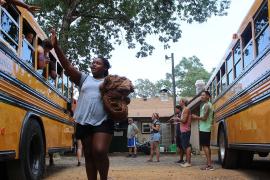
Over and above camp-related metrics, however, one of the most noteworthy attributes concerning camps is the significant role they play in child development. In that regard, it could be reasonably argued that camps provide one of the most effective platforms in America for developing the "whole child."
The Value of Play
That children benefit from play has been confirmed by years of research and empirical evidence. According to the American Academy of Pediatrics, for example, not only is unstructured playtime healthy for children, it is essential for their development (Ginsburg, 2007).
The question arises concerning why play is so important for a child's development. Similar to other issues related to children, a multiplicity of possible answers exists. The underlying consensus of these responses is that it is absolutely essential that children be afforded the opportunity to play to enhance their physical, intellectual, and psychosocial development. Perhaps no entity addresses this opportunity more effectively than the camp community.
The Whole Child
Articulating (in general terms) how the camp community helps children develop physically, intellectually, and socially/ emotionally is a fairly straightforward endeavor. While a certain degree of variation undoubtedly exists from camp to camp and child to child, depending on the circumstances and individuals involved, certain factors seem to be constant with regard to the potential impact of play.
- Intellectually
Play can stimulate a heightened sense of curiosity. The capacity of children to create a universe of their own making can help them expand their intellectual boundaries. When imagination and curiosity connect, the boundaries to creativity come tumbling down. No one who has ever witnessed children play in an unstructured environment can reasonably question the validity of this conclusion.
- Physically
One of the more common aspects of play is physical movement. Such movement can take many forms, including exercise, unstructured playful activity, and competitive sports. Each of these forms can be found in most camp environments. Without question, camps can have a positive impact on a child's physical development. In fact, with the elimination of physical education programs in schools in virtually every state in the U.S., camps have an unequaled opportunity to affect the physical development of children. Where else can children experience the joy of purposeful movement? Where else can children learn the true performance capabilities of their bodies?Where else can children learn carryover activities that may provide for a physically active lifestyle later in their lives? The need for camps to facilitate the physical component of the whole child has never been greater.
The American media coverage on the pervasive childhood obesity problem has been relentless. In fact, the issue is extremely serious (from a health standpoint) and becoming even more grave as time goes by. Statistics show that 17 percent of American children are obese (i.e., their body weights are at least 10 percent more than the recommended weights for their heights and body frames) and another 16 percent are deemed to be overweight (i.e., their body mass indexes [BMIs] are at the ninety-fifth percentile or higher). In other words, one in three American children has a problem with his or her weight, a situation that if left unchecked can lead to a number of health issues now and later in life.
The underlying genesis of the childhood obesity problem is fairly obvious. In our society, children tend to consume too many calories and move too little. In fact, this generation of children is the most sedentary group in American history. Among the more disturbing trends is the fact that the average child sits in front of a computer screen, television, or video game for roughly 7.5 hours per day, which translates into more than 50 hours of sedentary activity each week. Alarmingly, this unfortunate statistic has grown by more than an hour a day over the past five years. The key point to remember is if the precept "children move to improve" has validity, then the converse is also true.
- Socially/Emotionally
Play can also have a meaningful impact on the social/emotional development of children. For example, play can help teach a child how to relate to others. In that regard, play can help a child set ground rules and boundaries concerning their dependence on, and interaction with, others. Play can also provide a venue through which children learn key socialization skills such as how to be part of a group (team), how to manage conflict, how to display self-discipline, how to channel their own sense of competitiveness, how to deal with anxiety and stress, etc.
Ten Don'ts
Developing and instituting a strategy that can help camps ensure that their efforts with regard to play have the desired consequences can be a challenging task. In that regard, avoiding the following ten don'ts is recommended.
- Don't focus only on structured activities. Research suggests that children have an innate sense of joy that will manifest itself in play.
- Don't view kids as miniature adults. Children have their own unique physiological and psychological attributes that should be considered and addressed when formulating opportunities for them to play.
- Don't place too much emphasis on the competitive aspects of play. Some kids are more mature and more able to compete than others. Depending on the circumstances, competition can compromise the inherent fun in play.
- Don't let playful activities be dominated by one child or a handful of children. Without exception, play should be an inclusive activity.
- Don't use play, particularly calisthenics, as punishment. Punishment has a negative connotation. Play should be viewed from a positive perspective (as a reward), not as punishment.
- Don't be constrained by a lack of resources. When material items or funding limit the ability to perform a particular aspect or form of play, find an alternative that works. In reality, a person's imagination and creativity offer countless alternatives — options that require minimal accoutrements.
- Don't overcomplicate the process of play. To a point, the simpler the activity, the greater the likelihood that children will enjoy the experience.
- Don't forget to schedule time to play. Make sure that playtime is an integral and scheduled part of a child's day.
- Don't exclude any child from the opportunity to play. Every child deserves to experience the pleasure of play. Adopt an approach to playtime that ensures every child is an active participant, rather than a spectator.
- Don't ever neglect the fact that safety is always priority number one. No action (or inaction) should ever be taken that compromises the physical or emotional safety of a child.
Serious Business
It is often said that camps are in the "child development" business. Perhaps, a more apt description would be that camps are in the "whole child development" business. Play may serve as the underlying foundation of that business. As Peg Smith, chief executive officer of the American Camp Association, appropriately stated, "Play is the business of childhood. Taking play away from children puts them out of business. Play is the business of learning and experiencing life firsthand." A whole life.
Benefits of Physical Activity for Youth
Reference
Ginsburg, K. R. (2007). The importance of play in promoting healthy child development and maintaining strong parent-child bonds. Pediatrics, 119(1).
Cedric X. Bryant, Ph.D., FACSM serves as the chief science of ficer for the American Council on Exercise. Dr. Bryant lectures nationally and internationally on many topics related to exercise, fitness, and nutrition. He is an accomplished writer, having authored or co-authored over 250 articles and columns in leading sports medicine journals and fitness magazines.


